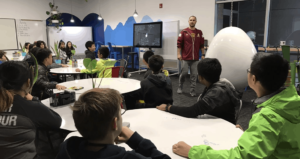Inclusion Drives Innovation, and Inspires Microsoft’s Newest Updates

By Madison Edmiston
It’s October, which means it is U.S. National Disability Employment Awareness Month. This year’s theme, “inclusion drives innovation,” fits perfectly with the new tools Microsoft is introducing to enhance education accessibility.
This year’s theme hits close to home for Microsoft’s CEO Satya Nadella, who is father to a son with special needs. Nadella believes technology “can help people find immense joy and a deeper connection to the world around them, by enabling them to realize their professional and personal potential,” and Microsoft is focused on making accessibility a top priority in their product development efforts. Through partnerships, Microsoft is delivering innovative technologies like Microsoft Learning Tools and Microsoft Translator for Education, and improving existing capabilities like Accessibility Checker in Office 365.
Microsoft is committed to “empowering every person and organization on the planet to achieve more.” That is why Microsoft recently announced it is extending Learning Tools’ Immersive Reader to Word for iPad, the “Read Aloud” feature was just launched for Microsoft Edge, and new third-party research showing the impact of Learning Tools on student learning outcomes. Here’s a look inside Microsoft’s newest tools that are supporting students with special needs.
Immersive Reader on iPad
Microsoft’s Learning Tools Immersive Reader features, Read Aloud and Text Spacing will be launched on Word for iPad in November, which will allow students to access the tool no matter what device they are using.
These new features provide greater support for individuals with ADHD, dyslexia and dysgraphia, and also emerging readers. The Read Aloud functionality can read text out loud while simultaneously highlighting the words. In addition, Word iPad Read Aloud supports all languages installed on the most recent version of iOS. While Text Spacing increases the spacing between characters, words and lines. These changes to the platform create inclusivity for all students, allowing students to benefit from Read Aloud and Text Spacing.
Read Aloud in Microsoft Edge
In the Fall Creator’s new update of Windows 10, Microsoft Edge incorporates Read Aloud features, including word and line highlighting. Now, any web page, including PDF files, will have the capability to use the Read Aloud feature. The update also allows users to select reading speed and a preferred voice for reading aloud. Another exciting improvement: with the newest update, Microsoft Edge’s Read Aloud will now support 49 languages.
New Learning Tools Research
In a new study, RTI International’s Center for Evaluation & Study of Educational Equity found that students using Microsoft’s Learning Tools saw a ten percent increase in reading comprehension across the board, including students with dyslexia, by enabling access to learning materials in other content areas like math, science and social studies. Students also showed improved writing when using Learning Tools because the tool allowed them to hear their own writing aloud, helping them to identify errors.
The teachers using Learning Tools in their classroom found that the tool supports cognitive processes that improve learning. During the study, teachers noticed how “Learning Tools enabled their readers, regardless of skill level, to access content aimed at a higher reading level. In this case, ‘access’ means comprehension of content that had previously been unavailable.” The fourth-grade students using Learning Tools had notably more growth in reading comprehension than their counterparts. The capabilities given to students through Learning Tools has also, according to the report, allowed students to feel more responsibility and control when it comes to their learning.
Microsoft’s Innovative New Features & Products
Microsoft has come together to create technologies that have the potential to benefit millions. Learning Tools was created during Microsoft’s Hackathon, when a team came together to focus on developing technology to assist children with dyslexia. Through this initial goal, Learning Tools has expanded to include features that help make writing and reading more accessible to all students.
Microsoft’s yearly hackathon has created other products targeted at enhancing accessibility as well. The winner of the first Microsoft OneWeek Hackathon, Eye Control, began as a passion project and is now a feature of Windows 10. The original project, the first Eye Gaze Wheelchair, allowed former NFL player Steve Gleason to control his wheelchair with only the movements of his eyes as he looked at the controls on his Surface. Since then, Windows 10 has been able to become more accessible with on-screen mouse, keyboard and text-to-speech experiences founded on Eye Control.
Inclusive design means more than just a single product or feature for Microsoft. Nadella believes that “inclusive teams that propagate and advance inclusive principles will have the deepest impact in building products designed for everyone.” This push for more accessibility is more than a company motto. To Nadella, it is his son, it is people helping people, and it is changing lives–and because of that it has the potential to change education.
For more, see:
- UDL: A Guiding Framework for a Personalized Learning Equity and Inclusion Agenda
- The Intersection of Tech and Design for Impactful Education
- 3 Ways to Connect to Students with Emotional Challenges
Madison Edmiston is a Coordinator at Getting Smart.
Stay in-the-know with all things EdTech and innovations in learning by signing up to receive the weekly Smart Update. This post includes mentions of a Getting Smart partner. For a full list of partners, affiliate organizations and all other disclosures, please see our Partner page.






0 Comments
Leave a Comment
Your email address will not be published. All fields are required.